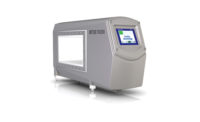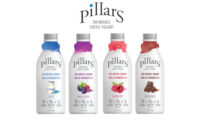For a fermented dairy beverage that originated in the Caucasus Mountains more than 2,000 years ago, kefir sure is having a moment. Innova Market Insights reports that the number of kefir launches grew more than threefold globally between 2011 and 2016. In the United States, beverages featuring kefir accounted for 40% of the drinking yogurt/fermented beverage introductions in 2016.
While it may be a stretch to call anything with two millennia of history new, kefir looks set to become the “new” Greek-style yogurt.
And yet it’s not just kefir that’s making waves in the fermented-dairy pool. All manner of drinkable yogurts are proving the sector to be fertile ground for innovation.
“Fermented milk products in general have a healthy image and are fantastic delivery systems for probiotic cultures,” said Jeff Lambeseder of DuPont Nutrition & Health, New Century, Kan.
No wonder then that industry insiders see the drinkable yogurt cup as well more than half full. Dairy Foods Ingredients Editor Kim Decker talked to some members of the “culture club” to learn how the latest culture strains from these suppliers are helping dairy processors make fermented dairy beverages better than ever.
Dairy Foods: Are your customers approaching you with more drinkable yogurt projects?
Lambeseder: We are seeing some increase in customers working on drinkable yogurt or kefir projects, often because these products are convenient ways to get a healthy meal or snack in on the go.
Mark Fahlin, DSM, Delft, The Netherlands: We see increasing demand for drinking yogurts globally. In Brazil, drinking yogurt is the No. 1 segment within the yogurt category. In North America, though, the drinking yogurt segment is still less than 10% of total yogurt sales, processors are looking to unlock more growth in this area.
Dairy Foods: What do you think is driving the popularity of drinkable yogurts more broadly?
Mirjana Curic-Bawden, Chr. Hansen, Milwaukee: Gen Ys and Millennials have different needs, habits, preferences and perspectives about food and about life in general. They want healthy, convenient, portable, all natural, clean label, authentic. Of course, it has to be tasty. Drinking yogurt can be designed to fit all these needs. And unlike soda or other beverages, it delivers all the goodness of milk and quenches thirst and hunger at the same time.
Fahlin: Convenience remains a key driver for drinking yogurt. It’s a healthy and affordable product that can be consumed on the go. This appeals to busy, active and health-conscious consumers and has led to a growing number of portable formats, such as carton boxes and squeeze bags that are easily consumed while traveling or at the gym, school or work.
John Lochinski, Kerry Americas, Beloit, Wis.: Digestive health is an area that’s receiving a lot of attention. Cultured drinks, especially kefir, are unlike most other dairy products because they’re more easily digested and contain little sugar (lactose) especially if fermented for a longer period. Therefore, they’re said to be suitable for consumers with lactose intolerance. Kefir also benefits from being on-trend with protein demand and naturally high in live and active cultures to support the immune system and gut health.
Dairy Foods: Define kefir for us and how is it traditionally made?
Fahlin: Technically speaking, kefir is not a yogurt. The production process is different, and kefir contains gas-producing bacteria. That’s why it’s known as the “champagne” of fresh dairy drinks. It’s a fermented milk product that looks and tastes similar to yogurt, but is slightly fizzy.
Ben George, Kerry Americas: Kefir contains more CFU [colony-forming units] per serving compared to other cultured dairy products. The high content of probiotics is what gives kefir its signature fizz that sets kefir apart from drinking yogurts.
Lambeseder: Traditionally, the Eastern European style of kefir is made with kefir grains, which are small, cauliflower-shaped granules formed naturally during the fermentation process and then collected for use in the next kefir batch. The grains consist of an undefined and symbiotic mix of Lactobacillus, Lactococcus, Leuconostoc, Streptococcus and multiple types of yeast. Traditional kefir will have a small amount of CO2, alcohol, aromatic compounds and a characteristic fizzy, acidic taste.
Dairy Foods: Is this process practical today?
Lambeseder: While the kefir-grain process may still be used today in some parts of Eastern Europe, usually it’ll be confined to very small producers due to the inconsistency of fermentation and strong flavor. But the cultures used for making kefir today can contain some elements of this process, conveying a new and unique beverage for the American consumer.
Dairy Foods: Tell us more about those cultures.
Curic-Bawden: If one looks through studies on the identity of traditional kefir grains, one learns that grains from different origins are different. They contain a wide range of bacterial species and yeast.
Fahlin: Kefir production can involve up to 12 different bacterial strains. Optionally, an additional yeast can be added to provide fizziness. Which cultures and bacterial strains to use all depends on the flavor and texture profile a producer wants to achieve.
Dairy Foods: Give us an example.
Lambeseder: Most of our customers making kefir in the U.S. and Canada ask for a culture that doesn’t contain yeast so they can avoid excess gas production during shelf life. For these customers, we have kefir cultures that are a combination of the yogurt cultures S. thermophilus and Lactobacillus bulgaricus and buttermilk cultures Lactococcus and Leuconostoc with added probiotics like L. acidophilus, L. rhamnosus, L. casei and Bifidobacteria.
Fahlin: Kefir is usually a sour product, and some consumers like their kefir to taste authentic and traditional. However, we’re seeing that U.S. consumers prefer their kefir relatively sweet, quite mild and with extra creaminess compared to its traditional taste.
Dairy Foods: Do kefir cultures require special care or handling during production?
Lambeseder: The heat treatment and incubation temperature will have a huge impact on the resulting product. For example, fermenting a culture at 110 F may give something that tastes more like a drinkable yogurt; the same culture fermented at 80 F can give a product that tastes more like buttermilk. Follow your supplier’s recommendations on heat treatment, fermentation temperature and time.
Dairy Foods: Do kefir’s traditional cultures make it a probiotic superfood?
Curic-Bawden: Here we come up against the same question, or dilemma, as in any other yogurt: Yogurt cultures and kefir cultures both ferment milk and impact texture and flavor. The cultures are live and active, but they’re not probiotics, as they don’t survive passage through the GI system. Some won’t even help with lactose digestion.
Probiotics are different. Probiotic strains are specially selected, extensively tested and backed with research and numerous clinical trials. They have to survive passage through the GI system and confer additional health benefits. So to confer health benefits, a documented strain should be added at sufficient levels as determined through clinical trials, typically from 1 to 10 billion CFU per serving.
Dairy Foods: Then does that mean that most kefirs we see in dairy cases aren’t really “all that” from a nutritional standpoint?
Curic-Bawden: Many consumers look at the number of species on the nutrition label as a sign of quality or healthfulness. Unless documented probiotics are added at an effective dose to confer a health benefit, modern kefir is just another form of drinkable yogurt or fermented milk.
But the name of the product doesn’t have to be “kefir” for it to be good for you. There are excellent examples of recently launched or yet-to-be-launched drinking yogurts with fewer added sugars that are made with documented probiotic strains.
Dairy Foods: Do the cultures used to make these drinkable yogurts differ considerably from those used in cup-set or stirred yogurts?
Curic-Bawden: Producing drinking yogurt is more a matter of the milk base formulation and process than the culture itself. Drinkable yogurt falls under the standard of identity for yogurt, so it has to be produced with a culture that contains Str. Thermophilus and Lb. bulgaricus.
As with any other yogurt, the culture choice depends on the target taste and flavor. It ranges from traditional yogurt flavor and very high acidity — like for Turkish ayran or some traditional products from the Balkan region or the Middle East — to medium yogurt flavor to very mild flavor and low acidity.
It’s also worth emphasizing that some cultures are more suitable for drinking yogurt. Strains are specially selected to allow for better stability and less sedimentation. This is very important for all natural, clean-label drinking yogurts that are made without the addition of stabilizers.
Dairy Foods: Other than poor stability and sedimentation, what pitfalls should a dairy processor beware of?
Drew Wunderly, DuPont Nutrition & Health: I don’t see a lot of formulation sensitivity in how the cultures grow. I do see how increasing the protein content can add dramatically more body or even “sliminess” in drinkable yogurt. Protein is a very popular addition but can bring viscosity, flavor and texture issues to the table if not addressed upfront. If you have an abundance of sugar in your formulation, you might notice some post-acidification from the cultures as you progress in shelf life.
Dairy Foods: Why is that a concern?
Curic-Bawden: The main issue has been post-acidification during processing and shelf life. Recently developed cultures have very low post-acidification and allow for the development of drinking yogurts that meet the demands of different consumer categories. Mild flavor and low and stable acidity allow for the optimization or reduction of added sugars without compromising product quality.
Fahlin: A culture that provides a stable pH after fermentation with almost no post-acidification allows for longer holding times at high temperatures. It makes production easier, too, as the cooling step before filling is limited to get maximum texture rebuilt in the yogurt. This gives dairy processors more process flexibility to standardize product quality throughout shelf life.
Dairy Foods: Speaking of reduced sugars, how can cultures help?
Fahlin: It’s a challenge for yogurt producers to reduce sugar levels in drinks. Using a culture that delivers a very mild taste and limited yogurt flavor allows for sugar reduction in the end product, especially in combination with lactase enzymes. The unique combination provides a sweet, natural taste compared to products fermented with a standard culture.
Dairy Foods: What are some other tips for optimizing drinkable yogurt?
Wunderly: A drinkable yogurt can be stabilized, but it also must be drinkable, and this trait allows for the appearance of many more defects, such as syneresis, protein agglomeration, separation and grittiness.
The best way to produce a drinkable yogurt is to use a “two-step” formulation. This would involve making a high-ester pectin slurry, pasteurizing it and then adding the slurry directly to the previously prepared yogurt prior to filling. The pectin helps prevent protein agglomeration in low-pH environments because it restores the polar steric repulsion between the protein particles.
If you use a “one-step” formulation, you’re simply trying to slow protein agglomeration by increasing the viscosity of the product. Many people have great success with one-step formulations, but there’s a tradeoff in the appearance versus ease of manufacturing.





